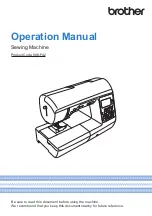
Names of Machine Parts and Their Functions
GE
T
T
IN
G RE
A
D
Y
Basic operations
B-7
B
Optional accessories
The following are available as optional accessories to be purchased separately. Optional accessories differ depending on your
model. For more optional accessories and their part codes, refer to the Quick Reference Guide.
1.
2.
3.
4.
5.
6.
Free motion echo quilting
foot “E”
Free motion quilting foot “C”
Quilting foot
Walking foot
1/4" quilting foot
1/4" quilting foot with guide
7.
8.
9.
10.
11.
12.
Quilting guide
Side cutter “S”
Open toe foot
Free motion open toe
quilting foot “O”
Non stick foot
Stitch guide foot “P”
13.
14.
15.
Adjustable zipper/piping
foot
Straight stitch foot and
needle plate set
Roller foot
Memo
• To obtain optional accessories or parts, contact your authorized Brother dealer.
• All specifications are correct at the time of printing. Please be aware that some specifications may change without
notice.
• A variety of feet are available to enable different types of stitching and finishes. Visit your nearest authorized Brother
dealer for a complete listing of optional accessories available for your machine.
• Always use accessories recommended for this machine.
O
P
Summary of Contents for 888-F42
Page 2: ...Cover2 3 PANTONE 285 C K ...
Page 41: ...Replacing the Presser Foot GETTING READY Basic operations B 33 B ...
Page 96: ...Decorative Stitching S 42 ...
Page 118: ...Cover2 3 PANTONE 285 C K ...
Page 119: ...Cover2 3 PANTONE 285 C K ...
















































